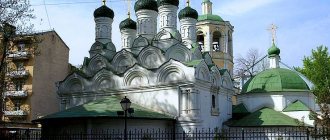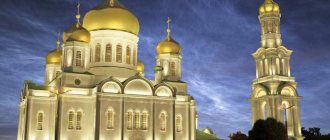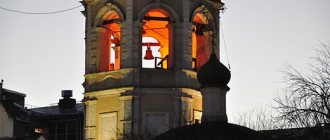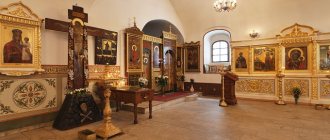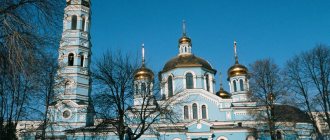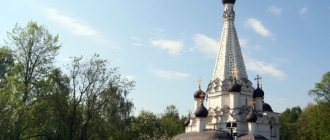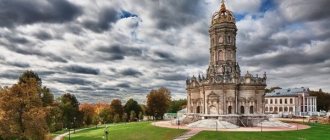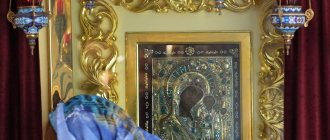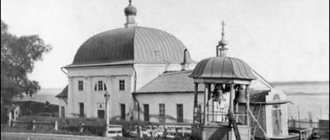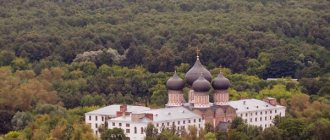The Church of the Nativity of the Virgin Mary in Putinki is one of the few tented churches that have not been destroyed to this day. It stood the test of time, the French invasion, Moscow fires and persecution by Soviet power. For more than 50 years, at the northwestern entrance to the Russian capital, the structure welcomed foreign ambassadors and travelers who stayed in the nearby embassy courtyard. Putinki was once a suburban settlement; since then Moscow has grown significantly and now the slender, elegant building perfectly adorns one of the streets of the historical center of Moscow.
Thanks to its convenient location, the church dedicated to the Nativity of Our Lady is visited by residents and guests of the Mother See on religious holidays, weekends, and simply while walking around the city center.
Description and location
The temple in Putinki, dedicated to the Nativity of the Mother of God, was erected and decorated in the traditional style of Russian patterning. It was completed just a year before Patriarch Nikon reformed the theological system and imposed a ban on the construction of tent-type religious buildings.
The Church of the Nativity of the Virgin Mary in Putinki is a unique example of architecture . In many ways it is not similar to other religious buildings of the 16th-18th centuries. So, there is no main facade in the building. From any angle it looks very beautiful and rich. When inspecting the structure, not a single detail protrudes or stands out.
The quadrangle in the building does not stretch from west to east (as is done in most churches), but from north to south. The bell tower is located not to the west, but to the northeast of the main part of the temple, next to three tents. Each of them is made of wood, has a small diameter (up to 3 meters), is closed from the inside and is only a decorative decoration.
The fourth tent, which was built north of the main three in the form of a separate cube, covers the aisle of the Burning Bush. All the drums of the tents are surrounded by three tiers of large and small kokoshniks. The main volume of the church is decorated with false zakomars, under which there is a carved frieze.
Please note: the Church of the Nativity of the Virgin Mary in Putinki is located in the Tverskoy district of Moscow, at the very beginning of Malaya Dmitrovka Street, in house number 2. The distance to the Kremlin is 2 km, to 3 metro stations built under Pushkinskaya Square - 100-150 meters. GPS coordinates of the building: 55.76705, 37.60687.
The bell tower of the church is built in the form of an octagon. In its tent there are many holes-roofs, which, together with large carved windows, make this part of the temple light and openwork. In total there are 9 bells suspended on it. 1-2 of them are used daily. The rest apply only on major church holidays.
You may be interested in an article with the history of creation and description of the Nikolo-Ugreshsky Monastery.
How to behave
It is required to go to all Orthodox churches and monasteries only in closed clothes:
- women: in skirts below the knees, blouses or closed dresses, scarves/kerchiefs and without makeup;
- men: in trousers, shirts, T-shirts, boots;
- It is forbidden to visit the temple in immodest clothing or flip-flops.
All these comments related to appearance. Now let's move on to the spiritual side of the issue:
- You can’t talk loudly or about extraneous things;
- try to pray to the Lord and not think about something worldly;
- When lighting a candle, be sure to pray.
The Church of the Assumption in Putinki is open to everyone who seeks prayer help from God, His Mother and the saints. Quietly approach each icon, read who is depicted, and mentally pray for health and salvation.
History of the temple
The source of Moscow temple architecture is separated from us by centuries: the first temple near the Tverskaya Gate of Moscow was built in 1625 from wood.
This is interesting: the construction of the stone Church began in 1649, and was carried out without special drawings. Architects and workers were guided only by drawings made on the ground or on paper.
The reason for the start of work on the construction of the building was a fire. The fire destroyed the old Church of the Nativity of the Virgin Mary to the ground.
The construction of the new church was completed in 1652. Then its consecration took place.
Interesting fact: construction was carried out with funds allocated from the treasury by Tsar Alexei Mikhailovich. In total, the king gave 800 rubles for the creation of the chapel. Of these, 400 are for the start of work, 300 for their continuation and 100 for completion.
Patriarch Paisius of Jerusalem petitioned for the allocation of money for the temple. Stone, lime and other materials also came from the ruler of the Russian land. A small portion of the funds needed for the construction were donated by parishioners.
Theodore Tyrone
At the end of the 17th century, a large dining hall and a room in honor of Theodore Tiron, decorated in the Baroque style, were added to the building. Monks and church servants lived and ate in these buildings. At the same time, a room for guards and an entrance to the belfry were erected. In 1715, during one of the repairs, a bell from the famous master Ivan Motorin, who cast huge bells for the churches of Kyiv and St. Petersburg, was hung on the latter. In 1781, the building was surrounded by a metal fence (it has not survived to this day).
In 1812, during the famous fire, the temple survived and did not receive any damage. In 1864, a small porch was built near the western wall of the chapel. In 1897 the church was restored. The renovation was led by architect N.N. Sultanov. In 1911, a residential building was built near the temple, which blocked the view of the tents and bell towers from the south.
The Church of the Nativity of the Virgin Mary is the only building of hipped-roof architecture of those years
The Church of the Nativity of the Blessed Virgin Mary in Moscow is the only church with hipped-roof architecture of those years. After the decree of Patriarch Nikon, there was a ban on the construction of tented churches. It was after this that cross-domed churches began to be built. This decree was canceled already in the 2nd half of the 17th century after Patriarch Nikon was expelled from the patriarchate.
Patriarch Nikon issued a decree banning the construction of tent churches. Photo: i.pinimg.com
At the end of the 17th century, a wide refectory with a chapel was added to the temple in honor of the Great Martyr Theodore Tiron, which included the older part of the church. There was also a guardhouse with access to the bell tower. In this place they decided to slightly enhance the exterior painting, and multi-colored tiles were also made.
Fate after the revolution and during the Soviet years
From 1918 to 1938, the Church of the Nativity of the Virgin Mary was open to parishioners. Since the beginning of the 30s, religious rites and services in the building were carried out by monks of the Vysokopetrovsky Monastery. In June 1935, the ordination of monk Alexy (rector) as Bishop of Kashira took place in the church. Later this priest became the Bishop of Alma-Ata and Kazakhstan.
Services in the temple were stopped at the end of 1935. The chapel was finally closed by the Soviet authorities in Moscow in 1938. After the cessation of religious activities, the chapel building housed several offices and warehouses.
In 1957, under the leadership of architect N. N. Sveshnikov and with the participation of corresponding member of the Academy of Architecture D. P. Sukhov, restoration work was carried out in the temple. During their implementation, the porch, built in 1864, was destroyed, and in its place a new one was erected, stylized to match the period when construction of the temple began - the mid-17th century. From this porch there is access to Malaya Dmitrovka.
It is important to know : it is known that the Soviet government sought to destroy and desecrate every shrine. So, in the 70s of the last century, the building was transferred to the Moscow branch of “Circus on Stage” and until the summer of 1990 served as a rehearsal base for this organization. It was used for training with dogs.
On January 2, 1990, the transfer of the temple to the ministers of the Orthodox Church took place. In the early morning of February 2, 1991, the first abbot, 33-year-old Abbot Seraphim, was brutally killed by a blow to the head with a blunt object in his own apartment. The building was opened in August 1991 for worship, Orthodox rites and requirements.
Since the late eighties, Alexander Abdulov, a famous Russian actor, has been actively donating to the restoration of the structure . He initiated the creation and organization of the “Backyards” festival. All money raised from this event went towards renovating the building. The proceeds from the film “Backyards-3” were used to pay for reconstruction work. After the death of Alexander Abdulov, on January 5, 2008, his funeral service was held in the church, which was attended by several dozen famous actors, musicians, and singers.
Moscow Assumption Cathedral in the 15th century
During the reign of Ivan III the Great, the Moscow state gained strength. The Assumption Cathedral ceased to correspond to the status of a cathedral. The chronicles mention that it became very dilapidated and was no longer repaired. Most likely, a decision had already been made to demolish the old one and build a new stone temple. The construction of the new church, the largest in size for those years, was entrusted to the Russian architects Myshkin and Krivtsov. At the end of April 1471 the first stone was laid. However, the construction could not be completed, since on May 20, 1474, an earthquake occurred in Moscow and the cathedral collapsed. After this, Ivan III invites the Italian architect Aristotle Fioravanti, who completely dismantles what remains of the destroyed temple. At this place, under his leadership, a building is being built on the model of the Assumption Cathedral, located in Vladimir. The Assumption Church is still located on Kremlin Square. The cathedral was consecrated in August 1479, the ceremony was performed by Metropolitan Gerontius.
Laconic architecture
The temple has a laconic and monolithic appearance . The unity of the building is emphasized by the uniform division of the facades using vertical flat projections. Smooth walls are crowned with narrow arcature windows. This is the name given to the rows of decorative false arches on the façade. Apses (lower projections of a building adjacent to the main structure) are not very high. They are covered with pylons from the north and south. The pylons are a tower-like structure in the shape of a truncated pyramid. The cathedral is decorated with five large towers topped with massive domes. Aristotle Fioravanti managed to cope with the most difficult task. He increased the internal volume of the cathedral, which Myshkin and Krivtsov failed to do. The Italian, for the first time in the temple architecture of Rus', used cross vaults with a thickness of 1 brick, as well as metal openings and intra-wall connections. Essentially, he applied reinforcement.
The main idea of the Italian architect
But the main engineering and architectural idea of the Italian master was that he built additional arches behind the iconostasis . Thanks to this, the eastern halls, united by the through passages of the cathedral, in fact became a monolith. Additional arches took on a significant share of the load from the colossal towers of the cathedral. This technique made it possible to build relatively thin round pillars in the western and central parts of the temple. This gave a feeling of unusual lightness of the large structure and its integrity with the main part of the pump. The naos is the central place in the temple where parishioners are present during worship.
Current state
Now the temple has been restored and renovated. Its appearance corresponds to that of the late 17th century. The walls and drums of the tents are covered with plaster and whitewashed, the roof is painted dark green, and the domes are dark blue. Most of the paintings inside the church are modern, but several faces have been preserved from the 17th century. There are icons on the walls. Candlesticks are installed near them. Parishioners have access to the church through a tent-covered porch from Malaya Dmitrovka Street. The building can accommodate no more than 2,000 people at the same time.
The lighting of the interior of the temple is provided by several chandeliers, which are suspended at a height of 4-6 meters. The appearance of the Virgin Church at night is emphasized by yellow lamps installed in the windows of the bell tower and blue lanterns attached to the bases of the domes.
Organizationally, the temple is part of the Moscow Patriarchate as a parish church. The building is assigned the status of a patriarchal courtyard. Its building is included in the register of cultural heritage sites of the Russian Federation under No. 7710206000. There is a Sunday school at the church. Near the building there is a car park and a kiosk for monastery baked goods.
Assumption Cathedral in the 17th century
The most significant events for the temple in the 17th century were the following:
- In 1613, the Zemsky Sobor was held here, at which Mikhail Fedorovich, the first of the Romanov dynasty, was elected tsar.
- In 1624, the church vaults were worn out and threatened to collapse. To avoid this, they were disassembled and reassembled according to the modified drawing, using additional reinforcement. They also erected additional girth arches, which increased the strength of the structure.
- In 1625, the Robe of the Lord, presented to Tsar Mikhail Fedorovich by the Shah of Persia Abbas I, was transferred to the Assumption Cathedral.
Information for pilgrims and tourists
- How to get there
You can get to the Church of the Nativity of the Blessed Virgin Mary using underground trains:
- Serpukhovsko-Timiryazevskaya (gray) line (Chekhovskaya station);
- Tagansko-Krasnopresnenskaya (purple) line (Pushkinskaya station);
- Zamoskvoretskaya (dark green) line (Okhotny Ryad station).
To the Pushkinskaya Ploshchad stop, which is located 100 meters from the temple, buses No. H1 and A run from Terminal B of Sheremetyevo Airport and from Luzhniki Stadium.
Take note: not to be confused with the Church of the Nativity of the Virgin Mary in the village of Gnilitsy, located in the Nizhny Novgorod region. The year of construction of the temple is approximately 1822; it does not belong to hipped architecture.
- Services and worship
On weekdays, services in the church open at 7:30, on weekends and holidays - at 9:00. Before the celebrations, all-night vigils begin at 18:00. At the request of believers, baptism and wedding ceremonies are held in the temple.
- Official site
It is better to find out more detailed schedule and official information directly in the temple or on the page dedicated to the Church of the Nativity. You can send a letter to its ministers by email, or call by phone.
- Patronal holidays
The patronal feast day of the church is September 21, when the holy birth of the Blessed Virgin Mary is celebrated.
Shrines
The temple has several revered icons with pieces of the relics of saints:
- Alexy, Man of God.
- Saint Luke Voino-Yasenetsky.
- Saint Panteleimon.
- Holy Princes Peter and Fevronia.
At the last three icons, an akathist is regularly read and a prayer service is performed. Anyone can join the worshippers. Sometimes miraculous icons are brought to the Church of the Assumption in Putinki from other cities and countries and placed in a prominent place so that everyone can notice and be able to come up, venerate and pray.
Photo gallery
[Show slideshow]
